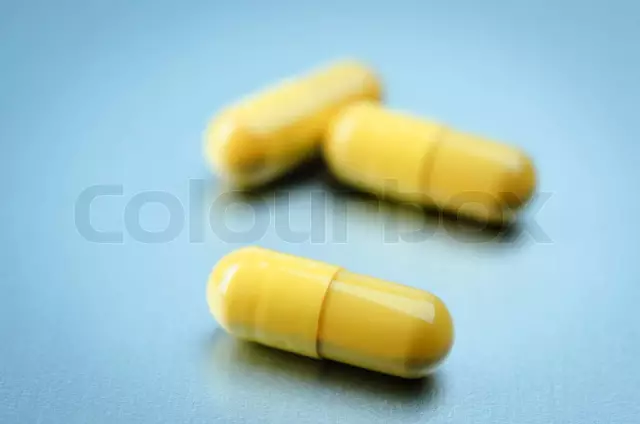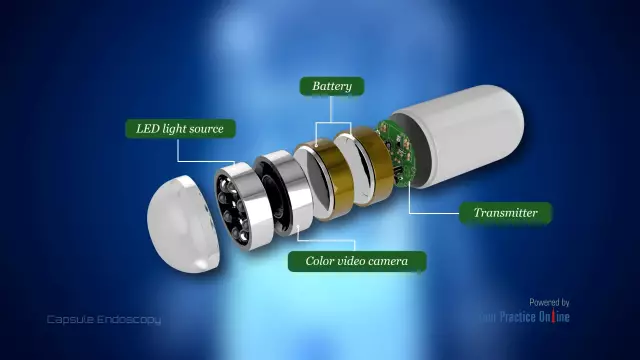- Author Rachel Wainwright [email protected].
- Public 2023-12-15 07:39.
- Last modified 2025-11-02 20:14.
Neurodolon
Neurodolone: instructions for use and reviews
- 1. Release form and composition
- 2. Pharmacological properties
- 3. Indications for use
- 4. Contraindications
- 5. Method of application and dosage
- 6. Side effects
- 7. Overdose
- 8. Special instructions
- 9. Application during pregnancy and lactation
- 10. Use in childhood
- 11. In case of impaired renal function
- 12. For violations of liver function
- 13. Use in the elderly
- 14. Drug interactions
- 15. Analogs
- 16. Terms and conditions of storage
- 17. Terms of dispensing from pharmacies
- 18. Reviews
- 19. Price in pharmacies
Latin name: Neurodolon
ATX code: N02BG07
Active ingredient: flupirtine (flupirtine)
Producer: Kanonpharma production, CJSC (Russia)
Description and photo updated: 22.11.2018

Neurodolone is an analgesic non-narcotic drug.
Release form and composition
Neurodolon is available in the form of capsules: size No. 0, gelatinous, solid, orange body and cap, inside capsules - white powder with small inclusions in the form of a compressed mass or a compressed mass of almost white color, which crumbles when pressed lightly (in blisters: 10 pcs., in a cardboard box 1, 3 or 5 packages, 15 pcs., in a cardboard box 1, 2, 3 or 4 packages).
1 capsule contains:
- active substance: flupirtine maleate - 100 mg;
- auxiliary components: pregelatinized starch, calcium hydrogen phosphate dihydrate, magnesium stearate, talc;
- composition of the capsule body and cap: gelatin, titanium dioxide, sunset yellow dye.
Pharmacological properties
Pharmacodynamics
Flupirtine is a non-opioid analgesic of central action, it belongs to selective activators of neuronal potassium channels. As a result of activation of G-protein-bound neuronal K + (potassium) channels of internal rectification, the release of potassium ions causes stabilization of the resting potential and a decrease in the excitability of neuronal membranes, which leads to indirect inhibition of ionotropic glutamate receptors, selectively binding N-methyl-D-aspartate (NMDA). Magnesium ions can block the activity of NMDA receptors until the depolarization of the cell membrane occurs.
The lack of binding of flupirtine in clinically significant concentrations with alpha1- and alpha2-, 5HT 1 (5-hydroxytrnptophan) - and 5HT 2 -opioid, central, serotonin m- and n-cholinergic receptors provides it with a central action and the realization of three main effects.
Selective opening of voltage-dependent potassium channels of neurons with the simultaneous release of potassium ions stabilizes the resting potential of the neuron, it becomes less excitable. The indirect antagonistic effect of flupirtine on NMDA receptors helps to protect neurons from the entry of calcium ions (Ca 2+) and to mitigate the sensitizing effect of an increase in the level of intracellular calcium ions. The analgesic effect of flupirtine occurs as a result of inhibition of the transmission of ascending nociceptive impulses upon neuron excitation.
At therapeutically significant concentrations, there is an increase in the absorption of calcium ions by mitochondria. As a result of the concomitant inhibition of impulse transmission to motor neurons and the effects of intercalary neurons, a muscle relaxant effect occurs, which manifests itself in relation to individual muscle spasms, without affecting the entire muscles in general.
The effect of chronicity processes is due to the plasticity of neuronal functions, which, through the induction of intracellular processes, creates conditions for the implementation of a mechanism that enhances the response for each subsequent impulse. Suppression of these effects occurs as a result of indirect blockade of NMDA receptors. Creation of unfavorable conditions for the clinical significance of pain chronicity and the erasure of pain memory of previously present chronic pain provide a decrease in pain sensitivity.
Pharmacokinetics
After taking Neurodolon inside, there is a rapid and almost complete (90%) absorption of flupirtine in the gastrointestinal tract.
In the liver, up to 75% of the taken dose of the drug is metabolized to form two metabolites. 2-amino-3-acetamino-6- (4-fluoro) -benzylaminopyridine, an active metabolite of M 1, is formed as a result of two reaction phases: the first is the hydrolysis of the urethane structure, the second is acetylation. Metabolite M 1 provides about 25% of the analgesic effect of flupirtine. The second metabolite M 2 (conjugate of p-fluorobenzoic acid with glycine) is biologically inactive. Since the isoenzyme of the oxidative degradation pathway of flupirtine has not been established, it is assumed that it will have little interaction potential.
T1 / 2 for the main substance and metabolite M 1 - 10 hours, which provides a sufficient analgesic effect. T1 / 2 of flupirtine - about 7 hours.
The plasma level of flupirtine is proportional to the dose taken.
T1 / 2 in patients over 65 years of age is 14 hours with a single dose, and more than 18 hours when taken within 12 days. Accordingly, the maximum concentration of flupirtine in their blood plasma is 2-2.5 times higher.
69% of the drug is excreted through the kidneys: unchanged - 27%, in the form of an acetyl metabolite (M 1) - 28%, in the form of p-fluorohydrogen acid (M 2) - 12%. In the form of metabolites of unknown structure - 1/3 of the dose.
A small part of the drug is excreted with bile and feces.
Indications for use
According to the instructions, Neurodolon is indicated for the treatment of acute pain syndrome of mild to moderate severity in adults.
Contraindications
- cholestasis and the risk of developing hepatic encephalopathy (due to the possible development of encephalopathy or aggravation of the course of existing encephalopathy or ataxia);
- liver disease;
- alcoholism;
- myasthenia gravis (gravis);
- the simultaneous use of drugs with hepatotoxic effects;
- Recently healed or existing ringing in the ears (due to a high risk of liver enzyme activity);
- period of pregnancy;
- breast-feeding;
- age up to 18 years;
- hypersensitivity to the components of the drug.
With caution, Neurodolone should be prescribed for renal failure, hypoalbuminemia, in patients over the age of 65 years.
During pregnancy, the use of the drug is possible only in the exceptional case when the expected therapeutic effect for the mother exceeds the potential threat to the fetus.
Instructions for the use of Neurodolon: method and dosage
Neurodolon capsules are taken orally, swallowed whole and washed down with plenty of water. It is advisable to take the drug while in an upright position.
It is allowed to take only the contents of the capsule, including if it is necessary to administer the drug through a tube. In this case, to neutralize the bitter taste of the powder, you can combine it with a meal (including a banana).
The dose should be selected individually, taking into account the tolerability of the drug and the intensity of the pain syndrome, prescribing the minimum effective dose for the shortest possible course of treatment. Neurodolon capsules should be taken at regular intervals.
Recommended dosage: 100 mg (1 capsule) 3-4 times a day. To relieve severe pain, the drug is indicated at a dose of 200 mg 3 times a day. The maximum daily dose is 600 mg, the maximum duration of the course of therapy is 14 days.
Patients over the age of 65 need dose adjustment. At the beginning of treatment, they should be prescribed 100 mg 2 times a day (morning and evening), then, if necessary and well tolerated, the daily dose can be increased to 300 mg.
In severe renal failure, Neurodolone can be taken if treatment is accompanied by regular monitoring of the concentration of creatinine in the blood plasma. The maximum daily dose is 300 mg.
No dose adjustment of Neurodolone is required in case of mild to moderate renal failure.
Side effects
- on the part of the immune system: often - hypersensitivity reactions, allergic reactions (including with fever, pruritus, rash, urticaria);
- from the nervous system: often - dizziness, depression, sleep disturbance, anxiety, nervousness, headache, tremor; infrequently - confusion of consciousness;
- from the side of metabolism: often - lack of appetite;
- from the gastrointestinal tract: often - dryness of the oral mucosa, nausea, vomiting, flatulence, dyspepsia, pain in the stomach, abdominal pain, diarrhea, constipation;
- from the hepatobiliary system: very often - increased activity of hepatic transaminases; frequency not established - liver failure, hepatitis;
- dermatological reactions: often - sweating;
- on the part of the organ of vision: often - visual impairment;
- others: very often - a feeling of weakness and / or fatigue (usually at the beginning of treatment).
Overdose
Symptoms: against a background of 5 g of flupirtine - nausea, dryness of the oral mucosa, tearfulness, tachycardia, prostration, stupor, confusion. In some cases, suicide attempts.
Treatment: no specific antidote; requires immediate gastric lavage or induction of vomiting, intake of activated charcoal. The appointment of forced diuresis, the introduction of electrolytes, careful monitoring of the patient's condition (including liver function), symptomatic therapy are necessary.
special instructions
Neurodolone is prescribed to patients for whom the use of pain relievers such as mild opioids or non-steroidal anti-inflammatory drugs is contraindicated.
Side effects are mainly dose-dependent, except for allergic reactions. During or after therapy, in many cases, symptoms disappear on their own.
Treatment should be accompanied by regular (once a week) monitoring of the liver function. If there are abnormalities or clinical manifestation of symptoms indicating liver damage, the capsules should be discontinued.
Symptoms of liver damage include the following conditions: lack of appetite, stomach pain, nausea, vomiting, dark urine, tiredness, jaundice, itching. When they appear, patients should immediately consult a doctor for examination and stop taking Neurodolon.
Flupirtine can give a false positive reaction to bilirubin, urobilinogen and protein in urine when using a strip test or when quantifying the concentration of bilirubin in blood plasma.
In some cases, high doses of Neurodolone can cause urine to turn green. This should not be intimidating to patients as this change is not a clinical sign.
Influence on the ability to drive vehicles and complex mechanisms
It is contraindicated to perform potentially hazardous activities during the treatment period, including driving, since the action of Neurodolon weakens the patient's attention and slows down the speed of his psychomotor reactions.
Application during pregnancy and lactation
You can not use Neurodolon during gestation, except in cases where, in the opinion of the doctor, the benefits of therapy for the mother outweighs the potential risk to the fetus.
Prescription of the drug during lactation is contraindicated, since flupirtine passes into breast milk. If you need to take capsules, breastfeeding should be discontinued.
Pediatric use
The use of Neurodolon is contraindicated for the treatment of children under the age of 18 years.
With impaired renal function
Neurodolone should be used with caution in renal failure, treatment should be accompanied by monitoring the level of creatinine in the blood plasma. In severe renal failure and hypoalbuminemia, the maximum daily dose is 300 mg. If a higher dose of the drug is required to achieve the desired therapeutic effect, then the patient must be provided with medical supervision.
With mild to moderate renal failure, dose adjustment is not required.
For violations of liver function
It is contraindicated to use Neurodolon for the treatment of patients with liver disease.
Use in the elderly
It is recommended to use flupirtine with caution for the treatment of patients over the age of 65 years.
The recommended dosage of Neurodolone: the initial dose is 100 mg 2 times a day (morning and evening). With good tolerance for the relief of intense pain, the daily dose can be increased to 300 mg.
Drug interactions
With the simultaneous use of Neurodolon:
- sedatives, ethanol, muscle relaxants: enhance their effect;
- verapamil, diazepam: increase their activity;
- warfarin, acetylsalicylic acid, benzylpenicillin, digoxin, glibenclamide, propranolol, clonidine: do not interact with flupirtine and do not change pharmacological properties;
- indirect anticoagulants (coumarin derivatives): should be used only under regular control of prothrombin time for timely correction of their dose;
- drugs metabolized in the liver: require regular monitoring of the activity of liver enzymes;
- paracetamol, carbamazepine: should not be taken while taking Neurodolone.
Analogs
Analogs of Neurodolon are Katadolon, Katadolon Forte, Nolodatak, Flugesik.
Terms and conditions of storage
Keep out of the reach of children.
Store at temperatures up to 25 ° C, protected from moisture and light.
Shelf life is 2 years.
Terms of dispensing from pharmacies
Dispensed by prescription.
Reviews about Neurodolone
The few reviews about Neurodolone give a low assessment of the therapeutic efficacy of the drug. Patients indicate that taking high doses of the drug does not completely relieve pain. In some cases, they had to combine the capsule with other pain relievers to achieve the desired clinical effect.
The absence of pronounced side effects is noted.
The price of Neurodolone in pharmacies
The price of Neurodolon for a package containing 15 capsules can range from 287 rubles, 45 capsules - from 664 rubles.

Maria Kulkes Medical journalist About the author
Education: First Moscow State Medical University named after I. M. Sechenov, specialty "General Medicine".
Information about the drug is generalized, provided for informational purposes only and does not replace the official instructions. Self-medication is hazardous to health!






